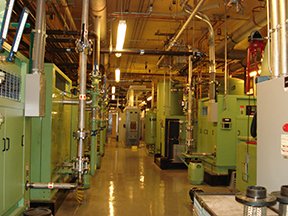The Fountain: Where Air and Water Meet
When we hear about the Fountains of Bellagio in Las Vegas or the Dubai Fountain at the Burj Khalifa in Dubai the first thing that comes to mind is likely the grandeur of the fountains and their choreographed performances set to lights and music. But beneath the surface of these world-famous attractions is a thoughtfully engineered design that aims to meet the same key drivers sought in any manufacturing setting: cost, energy savings and system functionality. Traditional fountains use pumps and pipes, but for displays of such size and power an air compressor has many benefits.
Maximizing efficiency and reducing energy usage are important considerations for any operation. Pumps and pipes must always be sized for maximum flow, but air compressors have the ability to generate for the mean demand and store what is not used for peak moments. This in turn requires about 20% of the energy of a pump in order to create the same result – ultimately leading to cost savings. In fact, according to an article in Machine Design, the Fountains of Bellagio would require a whopping 60,000 hp of pumps with a system sized for maximum load. Instead, operating at about 3000 hp and pushing over 10,000 cfm are the original 10 Sullair rotary screw compressors powering the water shooters and air receivers creating the famous mist effect with air pressures up to 510 psi.
Fountains of Bellagio compressor room
From design to serviceability, function is imperative. Air compressors have the advantage of a smaller footprint, taking up one-tenth the space pumps would require. Pipes sending compressed air out of the water shooters can also be much smaller and more inconspicuous when compared to the pipes that would be required to carry the water for equivalent jets – a crucial element when trying to maintain visual appeal. And when it comes to maintenance, an air compressor is a reliable source of energy and provides a long operating life with easily accessible parts for inspection and repairs.
Both the Fountains of Bellagio and Dubai Fountain were created by WET Design, a design firm holding 60 patents pertaining to lighting, water control and specialty fountain devices that use air compression technology. It’s no wonder for free attractions that typically run 365 days a year like these fountains, reducing energy usage and saving valuable dollars is critical.
So, what does this mean to you? An air compressor is not just a source of power, but ultimately a solution to a problem. Making informed and data driven decisions can help to maximize efficiency and reduce energy, maintenance and equipment cost. An air audit can provide an analysis of your compressed air system, helping you identify the right decisions and solutions for your operation. After all, if this can be identified for a fountain, it can be done for you.

